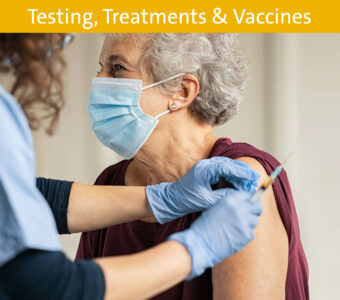My throat has a tickle. I hope it’s not COVID. Should I call my doctor? Should I ask for a COVID test? Do I need a COVID test? Do I just wait it out?
There’s a good chance that in the last year and a half, you or someone you love has had this type of internal monologue. The COVID-19 pandemic has heightened our awareness of cold-like symptoms. It’s made many of us hesitate as we grabbed a tissue or felt those tell-tale signals that a respiratory infection could be taking up residence in our body.
In November 2020, the Food and Drug Administration authorized the first COVID-19 test that you could take at-home. Since then, several others were authorized for use worldwide. The rapid test results allow you to test easily in the comfort of your home.
There are many questions about these tests – how do they work? Are they accurate? How much do they cost? We’re breaking down everything you need to know.
What are at-home COVID tests?
At-home COVID-19 tests allow you to swab at home or work. Some tests have you send your sample into a lab for results and others allow you to get your results right from the testing kit.
What kind of at-home tests are available?
There are currently two types of at-home tests available to detect active COVID-19 cases: molecular and antigen tests.
Molecular tests
Molecular tests look at bodily fluids, generally collected using a throat, nasal, or saliva swab. The tests check for genes, proteins or other genetic material that only come from the presence of SARS-CoV2.
Molecular tests are Polymerase Chain Reaction (PCR) tests, which is considered the gold standard of COVID-19 testing. PCR tests obtained at home need to be taken or sent to a lab for the results.
Antigen tests
The second kind of at-home COVID-19 test is an antigen test. This type of test identifies antigens (small protein fragments) in the body that the SARS-CoV2 virus sheds.
This type of test is also used to detect infections like strep throat and influenza. The results for this test are available in just minutes.
Home antibody tests are also available to indicate whether someone has previously had COVID. These home antibody tests are determined by measuring antibody in the blood and are not meant to indicate if someone has current or active COVID.
How do the at-home tests work?
Molecular tests are conducted by swabbing the nose, throat, or spit. The molecules necessary to diagnose the coronavirus are found in samples of bodily fluids. The swab is placed in a vial and shipped to a laboratory for testing.
Antigen tests require users to swab their nose and carefully follow ALL directions provided in the kit. Failure to follow step by step instructions can produce inaccurate results.
Many at-home tests are approved to be used in individuals age two and older.
Home-antigen tests are less accurate than laboratory performed PCR tests. However, when there is widespread community transmission, they are generally 90-95% accurate when positive. Some test kits may recommend a follow up test done 2-3 days later if the initial test is negative.
If you have a positive test, it is critical that you notify your healthcare provider and follow all isolation guidelines to prevent spreading COVID to others.
Are at-home tests accurate at detecting SARS CoV-2?
The FDA stresses that at-home tests can result in false negative and false positive results. If you have a positive test result, you should self-isolate and consult your doctor. If you test negative, but still have COVID-like symptoms, you should also consult your doctor.
What are the pros and cons of at-home tests?
There are many positive features of the at-home COVID-19. The tests are more portable and accessible to people than lab tests. The tests do not require a specialist or lab to be completed, and they are more affordable than lab tests. Also, the tests produce results within minutes rather than days.
Of course, there are potential negative factors as well. The at-home tests are more accurate when testing people symptomatic with COVID-19 rather than those who are asymptomatic.
Hospital tests are more accurate than at-home tests. Antigen tests generally have a higher false negative rate than molecular tests.
Finally, some places – such as universities and workplaces and public health departments – offer free testing.
How accessible are the tests?
At-home tests can be purchased from the websites of the specific brands, as well as places like Amazon, Walmart and CVS.
Price wise, the at-home tests are considerably more affordable than home collection tests that are sent into labs. We found the prices for the tests range from $14 to $39.
We’ve also found that free tests are being made available through community resources and health departments – so check around before you buy!
Which brands are rated most highly?
All the tests are safe to use, so it’s best to decide what’s best for you and your famiy by looking at the available options. Here are three to consider:
BinaxNOW has a COVID-19 antigen test. This is one of the cheapest options available, authorized by the FDA and completed in 15-30 minutes.
The Ellume COVID-19 test kit is associated with a companion application that delivers results on your smartphone in 15 minutes. The kit has the materials needed for one swab test.
The Quidel QuickVue COVID-19 is different in that it is designed for you to test twice in two to three days. Results for this test are available in about ten minutes. The brand is available in single packages or packs of 45.
Why are these tests being discussed now?
Recently, with the prevalence of the delta variant and resurge of the pandemic, any efforts that can be made to help stop the spread are key. Vaccinations are the best defense against preventing disease. we have currently, but we’re looking toward antiviral medications and other methods to help provide protection once exposed to disease.
As the school year continues, it’s essential to keep up with testing as recommended by school districts, healthcare providers and CDC after exposures, especially for those who are not vaccinated. At-home tests help reduce time spent in lines.
At-home testing could play a major part in disease control, stopping the spread of COVID-19 by quickly identifying and isolating cases and in turn, keeping schools and businesses open.





